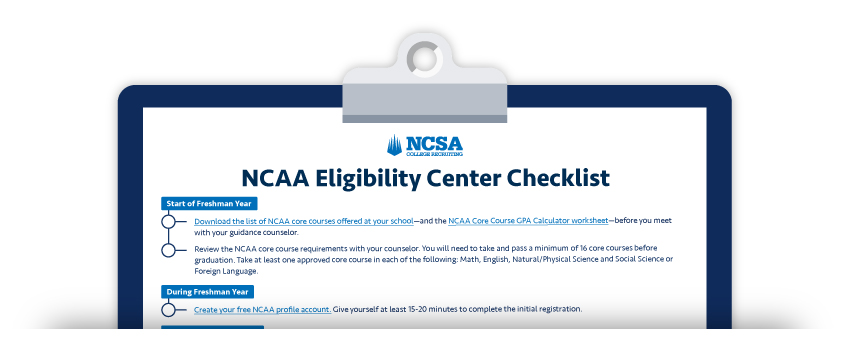We created an NCAA Eligibility Center Checklist for student-athletes to order to provide a timeline of what you should be doing—and when—to ensure you’re on track to meet the NCAA eligibility requirements.
Using the Eligibility Center Checklist
The NCAA Eligibility Center determines academic eligibility and amateurism status for student-athletes in Division 1 and Division 2. Student-athletes must understand and meet NCAA academic and amateurism requirements. Although the NCAA doesn’t ensure compliance, it allows collaboration with high school counselors and administrators to help students meet eligibility criteria, including course requirements, GPA, and timely transcript submission.
Click on the links below to see what should be done during each year in high school:
On This Page
The NCAA no longer requires standardized test scores for initial eligibility in D1 and D2 colleges. However, some schools and scholarships may still ask for them for admission. To confirm the requirements of your specific NCAA school, it’s best to contact them directly.
Start of Freshman Year
- Download your high school’s list of NCAA-approved core courses—and the NCAA Core Course GPA Calculator worksheet—before you meet with your guidance counselor.
- Review the NCAA core course requirements with your counselor. You will need to take and pass a minimum of 16 core courses before graduation. Take at least one approved core course in each of the following: Math, English, Natural/Physical Science and Social Science or Foreign Language.
During Freshman Year
- Create your free NCAA profile account. Give yourself at least 15-20 minutes to complete the initial registration.
Start of Sophomore Year
- Review your transcript with your guidance counselor to ensure you’re on track to meet the NCAA core course requirements. Take at least one approved core course in each of the following: Math, English, Natural/Physical Science and Social Science or Foreign Language.
During Sophomore Year:
- OPTIONAL: Take the PSAT to familiarize yourself with standardized tests like the ACT and SAT (Not required for NCAA eligibility).
Get the NCAA Eligibility Center Checklist
Start of Junior Year:
- Receiving D1 or D2 interest? Create an NCAA Certification Account (cost: $100 for athletes in the U.S., Canada and U.S. Territories and $160 for international athletes)
- Have your counselor send your current transcript to the NCAA Eligibility Center.
- Review your transcript using the core course calculator with your guidance counselor to ensure you’re on track to meet the NCAA core course requirements. Take at least one approved core course in the following: Math, English, Natural/Physical Science and Social Science or Foreign Language.
Insider Tip: You need to complete 10 of the 16 required core courses by the end of your junior year (before the start of your seventh semester). Seven of the 10 core courses need to be in English, Math or Natural/Physical Science. The grades in these seven courses will be “locked in,”—you will not be able to retake them to improve your grades.
During Junior Year:
- OPTIONAL: Take your first ACT and/or SAT—this will give you time to retake it if needed (Not required for NCAA eligibility).
- Review your transcript using the core course calculator with your counselor to ensure you’re on track to meet the NCAA core course requirements. Focus on the 10 core course rule—make sure you are on track to complete 10 of the courses by the end of the year, and remember that seven of these courses will be “locked in.”
End of Junior Year:
- Have your counselor send your transcript to the NCAA Eligibility Center after completing your sixth semester.
Start of Senior Year:
- Review your transcript using the core course calculator with your counselor to ensure you’re on track to meet the NCAA core course requirements. You should know the exact courses you will need to take to hit eligibility based on your meeting at the end of your junior year.
- OPTIONAL: Take your second (or third) ACT and/or SAT if necessary (Not required for NCAA eligibility).
During Senior Year:
- Complete your amateurism questionnaire within your NCAA Certification Account.
Starting April 1 of Senior Year:
- If you’re enrolling in the Fall semester, you can request your final Amateurism Certification within your NCAA Certification Account on or after April 1 and if you’re enrolling in the Winter/Spring semester, on or after October 1. Remember, April 1 (Fall semester) and October 1 (Winter/Spring semester) are just the first—not the only—day you can request Amateurism Certification.
End of Senior Year:
- Have your counselor send your final high school transcripts and proof of graduation to the NCAA Eligibility Center.
